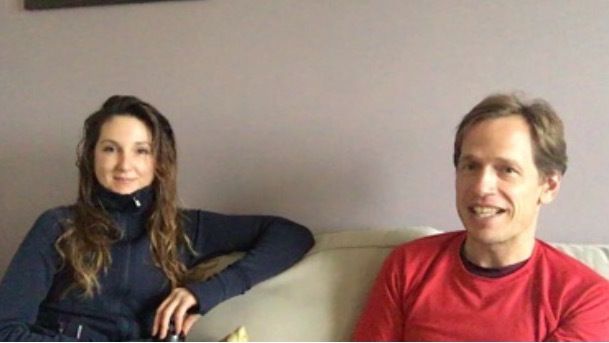
Steve Alsdorf and Sarajean Rudman trail running in the Berkshires
How are you managing your stress?
If you’ve been practicing mindfulness meditation in order to get better control of your emotions and simply feel better but your brain wanders after two seconds, I’ve got an idea for you.
Go trail running.
Or even trail walking.
Because when you’re on a trail and you’re not zooming in on the right here, right now, an exposed tree root or a pile of wet leaves or a single smooth stone can take you down.
Literally.
“On a trail run everything is constantly changing so you have to pay attention,” said Stephen Alsdorf, M.D., just before a group trail run at Kripalu Center for Yoga & Health a few weeks ago.
You could practice mindfulness meditation when you’re running or walking on a treadmill or in your neighborhood because if you don’t you could slip off the back of the machine or get hit by a car.
But trail running takes mindfulness to a whole new level. And like other connections between yoga and running, that’s a good thing.
On the uphill you’re aware of your breath and your heart rate as you navigate the trail and stop and walk if that’s what your body needs. On the downhill, you’re relaxed and letting go of the tension in your muscles, which can be scary and requires every bit of your focus.
There is no room to think about anything else.
Kripalu, a nonprofit educational organization, invited me to attend the weekend trail running workshop, led by Steve, who practices family medicine in nearby Pittsfield, and Sarajean Rudman, runner, yogi, and fitness expert and certified Ayurveda health counselor.
It was unseasonably warm and balmy when I left Washington to head up to the Berkshires, but by the time we pulled into the Kripalu parking lot, there was an icy chill in the air, and I was glad I packed my cold gear.
Kripalu is situated among 300 acres of grounds, woodlands, and trails in Stockbridge, Massachusetts, adjacent to Tanglewood music festival. Some of the trails have simple markings, but many are unmarked, too.
The 16 workshop participants included both experienced and new trail runners. Over the course of the weekend, we did three group runs, two on Saturday in cold, wet weather, and one on Sunday where the temperature was brisk but the sun was shining and the sky was blue. All of the runs began and ended in the studio with yoga incorporating stretching and core exercises specific to trail running, including Sarajean’s harvesting awareness practice. Kripalu brought in area athletes who joined us on our runs as pacers at the beginning, middle, and back of the group. The runs were between 3.5 and 4 miles each.
It’s a no-runner-left-behind running culture at Kripalu, and the goals above all else are enjoyment and safety and achieving a sense of wellness.
“What I tell my patients is the things that are going to keep you healthy in the long run are your habits,” Steve said. “Exercise is right at the top of that.” I interviewed Steve and Sarajean between trail runs during the weekend.
While trail running, or off-road running, is a sport that attracts elite athletes, and trail marathons and trail ultraraces are more popular than ever, trail running appeals to slower-pace runners and new runners but even non-runners, Steve said, because the distances for the average recreational runner tend to be shorter and the pace of trail running is slower.
And because you’re in nature and it’s fun and it gives you a chance to practice mindfulness, which we all want to do.
Steve, himself, who didn’t start running until his 40th birthday, has an average trail pace of 10-12 minutes per mile, although his pace can be much slower on extreme terrain. For example, he averaged 16 minutes per mile at the 7 Sisters Trail Race, which follows the New England National Scenic Trail in Amherst, in May. Whatever his pace, his goal is never about distance.
“Trail running is necessarily a combination of running and walking and how just being in nature can foster awareness,” Sarajean said. “As you climb up a hill, you want to be aware of how your body is feeling, and walking may be a way to keep you focused.”
“It’s about finding the enjoyment in being outside and being physical,” Steve said, and the idea that nature is nurture.
While we know the health benefits of both exercising regularly and practicing mindfulness meditation, there is separate research that shows just being in nature, including shinrin-yoku, the Japanese practice of “forest bathing,” or immersing yourself in the natural world and drawing on all of your senses, can lift your spirits, improve cardiovascular health, boost your immune system, and even possibly lower your risk of cancer, Steve said.
Technically you can forest bathe sitting on a bench, but we were at Kripalu to move around. So when our bath turned into a shower on Saturday afternoon as it began to sleet we returned to our rooms to change into dry clothes before meeting back in the yoga studio.
How did the experience make us feel?
Out there we were cold and wet.
And the uphills were hard and the downhills even harder.
Yet we felt unbelievably great.
Simply awesome.
I asked Steve if he’d ever experienced a face plant, not exactly a welcome encounter with nature but kind of a possibility if you’re running up and down on uneven surfaces.
“Absolutely,” he grinned.
“That usually happens when I’m thinking about something other than the trail in front of me.”
But it could also be because runners do not typically train for running or walking on uneven surfaces, according to physical therapist and clinical sports specialist Kevin McGuinness who practices at Washington Orthopedics and Sports Medicine in Washington, D.C.
Including running downhill on uneven surfaces.
At the workshop we talked about our impulse to hold ourselves back, particularly running downhill. Yet the goal is to lean into the momentum. Kind of like steering your car into a skid when it’s icy instead of braking.
I thought about this later that Saturday evening when I attended Kripalu’s lecture by author and meditation teacher Sharon Salzberg. Sharon was talking about self compassion when she told about the time she first moved to New York City. She was riding the elevator in the hotel where she was planning to stay until she found a place to live and realized her entire body ached.
“I was standing in the elevator still gripping my luggage when it dawned on me: Just drop the suitcases and let the elevator carry them.”
Letting go doesn’t necessarily come naturally.
When I returned to Washington I asked Kevin about trail running because it’s not something we’d talked about incorporating into my exercise regimen. I enjoyed it and wanted to find ways to bring it into the mix.
While road, track, or treadmill running might predispose you to overuse injuries, Kevin said, trail running could increase the risk of a traumatic injury such as a fall or ankle sprains and Achilles strains.
“It takes as much force to decelerate on the way down as it does to accelerate on the way up, and that’s not a motion that runners train very often,” Kevin said. “It’s a landing and breaking force rather than a push off and accelerating force. Even though the same muscles are at play, it’s a completely different, almost reversed action, on a lot of the joints and musculature.”
The good news is trail runners can focus on increasing balance training especially on uneven surfaces and some people, after getting the green light from a physician or an exercise specialist, might benefit from an increased emphasis on plyometric training.
Think box jumps instead of squats.
You want to make the muscle not just stronger but also more powerful so you can move yourself and stop yourself with good control, Kevin said. But like anything you try that’s new, you want to go at it slowly and gradually, in order to avoid injury and keep it fun.
So here’s the thing.
The ability to enjoy any kind of running can be more difficult than other forms of training, Kevin reminded me, because for many of us, including me, running can be hard.
Just like practicing mindfulness meditation.
But if you can find a way to make running more joyful, more fun, you are more likely to focus on your sleep and your diet and improve the other things in your life that let you go for that run the next day.
Tips for a Great Trail Run
Running form
- Stay tall and relaxed and light on your feet (think hopping from root to root or rock to rock or even tiptoeing through the tulips)
- Short strides, both on the uphill and on the downhill
- An evenly weighted foot-strike with slight emphasis on ball over heel means calf muscles are always available for engagement and stabilization. (You don’t want to be constantly engaging your calf muscles and Achilles as this could lead to overuse, soreness, and potential injury, but you do want them right there and ready but relaxed)
Shoes
- Comfortable running shoes without much heel elevation
- Overly cushioned shoes or high-stability shoes can make it more difficult to feel the path, making you more susceptible to missteps. Steve runs in zero-drop, minimalist shoes. Sarajean is a fan of Altra shoes, which have a zero-drop and a wide toe box and come with a rock guard insert to prevent you from getting impaled by a root or sharp rock on the trail.
Efficiency
- Work = Force x Distance
- Force = Strain or tension
- In other words, to work less, use less force. Steve highly recommends ChiRunning for smooth and efficient running
- Workshop participants said what they worried about most on the trail was the downhill and how to slow down. Steve and Sarajean emphasized the importance of relaxing your muscles on the downhill and giving into the speed. This takes practice and skill
- Steve and Sarajean laid out yoga blankets, pillows, and blocks in a series of obstacle courses in the studio. Then they asked us to remove our shoes and run through the courses in our socks, learning how to go with the movement rather than try to stop or slow ourselves
- On a trail run, you want to let momentum carry you forward
- Body scan. Make sure your muscles are relaxed. Shoulders and arms, too
Breathing
- Breathe through your nose when possible. You will need to ease up dramatically to do this, especially at first. Focus on a slow exhale to engage your parasympathetic nervous system
- Slow down or take walk breaks to keep your breathing easy
Prevent injury
- Walk whenever you feel like walking (or whenever there’s a good view to take in)
- Pay attention
- Note tension and relax it
- Never run through joint pain
- Keep it fun
- Enjoy every moment!
Information on weekend and week-long workshops focusing on running, including an upcoming workshop on ChiRunning, and yoga for athletes can be found on the Kripalu website. And check out the new Run Yogi Run podcast with Cara Gilman and Sarajean Rudman.
You can find some of the best trail runs in the United States here or you can look for great trail runs near you. Learn more about trail running at the American Trail Running Association.

Sarajean Rudman and Steve Alsdorf: Just get out there and enjoy being in nature
